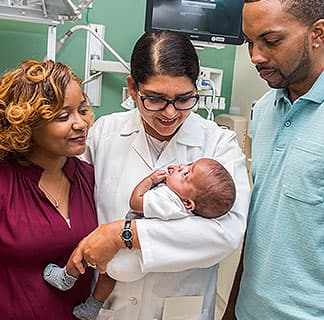Creating a treatment plan for placenta accreta during pregnancy

The University of Chicago Medicine maternal-fetal medicine team, housed in the Family Birth Center, provides care for moms-to-be and babies. Our maternal-fetal medicine specialists provide high-risk obstetrical care to women, some who are referred by physicians from across Illinois and northern Indiana — like 39-year-old Katrina Calhoun.
Calhoun was an OB/GYN patient at a nearby hospital when her doctor had concerns about her MRI and referred her for maternal-fetal care.
“I felt like my hospital was sending me somewhere that would properly take care of me,” said Calhoun.
Calhoun was 31 weeks pregnant and the ultrasound showed that she had a placenta accreta, a type of abnormal placentation.
What is placenta accreta?
Normally, the placenta develops during pregnancy and attaches inside the uterus. It grows onto the upper part of the uterus and stays there until the baby is born. The umbilical cord connects to the placenta and passes blood, oxygen and other nutrients to the baby. During the last stage of labor, it’ll separate from the wall of the uterus, and contractions will help push it into the vagina (birth canal).
With a placenta accreta, the placenta will attach to the top or side of the uterus instead and attach itself too deeply into the uterine wall. Because the placenta is deep into the uterus, it doesn’t completely separate from the uterus during delivery, which can cause dangerous bleeding.
Calhoun’s care was transferred to the maternal-fetal medicine team. With our experts, she now had access to the Family Birth Center, where our multidisciplinary team was poised to offer comprehensive care. Placenta accretas require a highly specialized and coordinated effort to maximize safety during and after delivery.
At UChicago Medicine, we have the blood bank and the subspecialists that we need to make these cases go as smoothly as possible. Plus, we’re able to take care of the patients that become more complex.
What leads to a placenta accreta?
Research has yet to prove why a placenta accreta will occur; however, they often happen in women who have had a prior cesarean section (C-section). Calhoun had two previously.
The layer behind the endometrium, the innermost lining layer of the uterus, is injured during a C-section and it doesn’t heal back to 100 percent, leaving a space for the placenta to attach to directly.
Other factors that may lead to a placenta accreta are:
- Maternal age over 35 years
- Previous gynecologic surgeries
- A placenta abnormally positioned in the uterus
- In vitro fertilization
How do you treat an accreta?
Calhoun met with her care team, and together they devised a treatment plan. Calhoun would deliver by C-section at 35 weeks and right after delivery, remove her uterus with a hysterectomy. The surgery would take three hours.
It’s very important to coordinate delivery when the patient has an accreta to prevent the patient from experiencing life-threatening blood loss, which can occur if the patient suddenly goes into labor. A treatment plan is also helpful because it allows the patient the opportunity to understand the effects of a hysterectomy and ask any questions that may arise.
“I didn’t think of it as if they were taking something away from me. I thought of it like they were taking care of me,” said Calhoun.
If a patient does not want to have a hysterectomy, the surgeon may attempt to separate the placenta from the uterus. If the patient is not bleeding heavily, the surgeon can take out the section of the uterus attached to the placenta, or alternatively, remove some of the placenta and leave the parts that are attached to the uterus. However, about 40 percent of patients will start to bleed if those tissues are left inside.
What is the recovery time after treating a placenta accreta?
Blood loss is expected during a delivery when a placenta accreta is present; however, Calhoun didn’t require a blood transfusion. She stayed in the hospital for three days after delivery and didn’t experience any of the bleeding common for this surgery.
Two weeks later, she had a follow-up appointment to check her incision, and six weeks after that, a routine follow-up appointment. Her delivery went really well, so her recovery was that of a regular C-section.
Calhoun took home a healthy baby girl, Adalynn, who is the pride and joy of her two older brothers, ages 9 and 14. Calhoun said that she appreciated her experience with our maternal-fetal medicine team: “The experts I was referred to actually didn’t feel like doctors but like very knowledgeable friends who so happen to be doctors."

Distinguished Expertise in Maternal-Fetal Medicine
Our experts specialize in diagnosing and managing health conditions that place expectant mothers and their babies at elevated risk for potential complications during pregnancy and birth.
